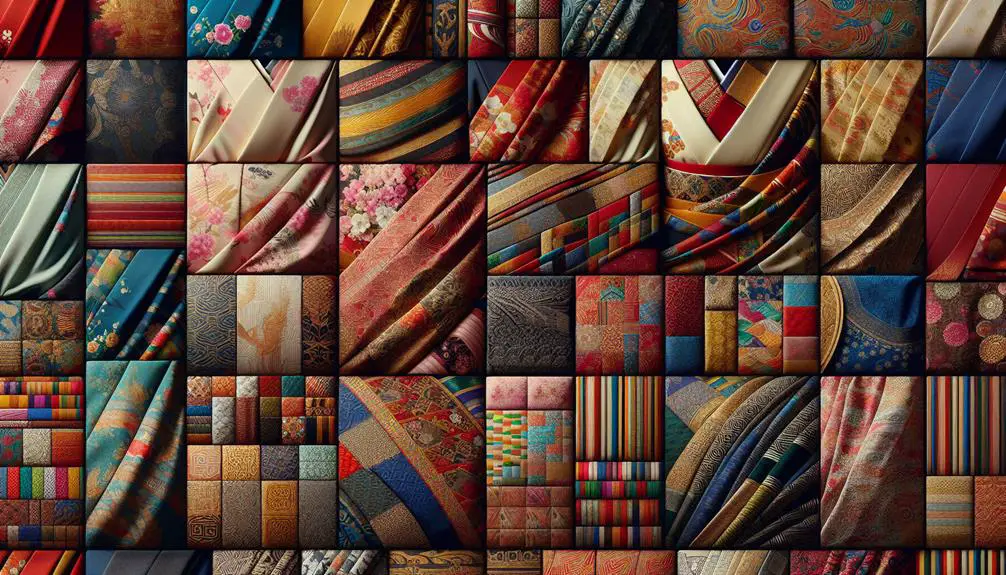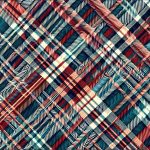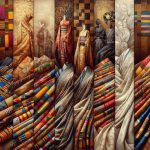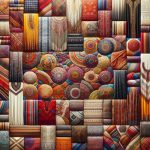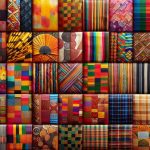When you think about fabrics, you might just picture clothing, but they're so much more than that. In various cultures, fabrics like African Kente Cloth and Japanese Silk Kimonos serve as vibrant storytellers, each thread weaving history, identity, and tradition. Have you ever wondered how the Indian Sari's colors represent India's diverse heritage, or why Scottish Tartan patterns are so essential to clan identities? These textiles connect generations, blending artistry and craftsmanship. Curious about how these fabrics preserve cultural legacies and what stories they tell? Let's explore their deeper significance.
Table of Contents
Key Takeaways
- Fabrics symbolize cultural identity, heritage, and history, such as Scottish tartans representing clan affiliations.
- Traditional weaving techniques preserve cultural legacies, seen in Peruvian alpaca wool weaving.
- Patterns and colors in fabrics often convey symbolic meanings and stories, like African Kente cloth's proverbs.
- Garments like the Indian sari and Japanese kimono reflect regional diversity and social status.
- Sustainable fabric production supports local economies and ethical practices, exemplified by alpaca wool in Peru.
African Kente Cloth
Often celebrated for its vibrant colors and intricate patterns, African Kente cloth holds deep cultural significance and historical importance.
You'll find that the color symbolism in Kente cloth is fascinating: black represents spiritual strength, gold signifies royalty and wealth, while green stands for growth and renewal. Each hue conveys a specific message, reflecting the wearer's status or intentions.
Diving into the weaving techniques, you'll appreciate the skill required. Crafted on traditional looms, Kente cloth is woven in narrow strips, which are then sewn together. The patterns aren't merely decorative; they often tell stories or symbolize proverbs, making each piece a tangible narrative of African heritage.
The historical evolution of Kente cloth is equally compelling. Originally reserved for royalty and special occasions, it has evolved over centuries from a symbol of power to a fabric embraced globally.
In modern adaptations, Kente cloth has found its way into contemporary fashion, home decor, and even digital prints, bridging tradition with modernity.
You can see how Kente cloth encapsulates a rich tapestry of history, culture, and artistry, making it a unique and enduring symbol in African and global contexts.
Japanese Silk Kimono
In the heart of Japanese culture, the silk kimono stands as a timeless embodiment of elegance and tradition. When you explore the art of kimono design, you're not just looking at a piece of clothing; you're unraveling a rich tapestry of history and meticulous craftsmanship. Silk production in Japan has been refined over centuries, resulting in a fabric that's both luxurious and durable.
A true connoisseur of Japanese heritage will appreciate the intricate elements involved in creating a silk kimono. Here are four key aspects to ponder:
- Silk Weaving: High-quality silk threads are woven with precision to create a smooth, lustrous fabric that serves as the kimono's foundation.
- Dyeing Techniques: Traditional methods like Shibori and Yuzen dyeing add vibrant colors and intricate patterns, making each kimono a unique work of art.
- Seasonal Motifs: Designs often reflect the changing seasons, with motifs like cherry blossoms for spring or maple leaves for autumn, celebrating nature's beauty.
- Formal vs. Casual: Different kimono designs denote various levels of formality, from the elaborate furisode worn by young women to the more subdued komon for everyday wear.
Indian Sari Tradition
When you investigate the Indian sari tradition, you'll uncover a rich history woven into every thread of this iconic garment. The sari isn't just a piece of clothing; it's a symbol of India's diverse cultural heritage.
Mastering the art of sari draping is essential to fully appreciate its beauty and significance. Whether it's the Nivi style from Andhra Pradesh or the Bengali style, each draping method tells a unique story and showcases regional identity.
Fabric motifs play a vital role in distinguishing the various types of saris. You'll find intricate paisley patterns, floral designs, and geometric shapes that aren't just decorative but also hold cultural significance.
For example, the Banarasi sari is known for its Mughal-inspired motifs, while the Kanjeevaram sari features temple borders and mythological scenes. Each motif is meticulously crafted, often using techniques passed down through generations.
Understanding the rich tapestry of the Indian sari tradition will deepen your appreciation for its craftsmanship and cultural importance. As you explore further, you'll see how this garment serves as a canvas, capturing the essence of India's history, artistry, and regional diversity.
Scottish Tartan Patterns
When you look at Scottish tartan patterns, you're seeing a vibrant symbol of clan identity. Each pattern tells a story, reflecting the history and heritage of different Scottish families.
You'll also find that the unique weaving techniques used to create these patterns are a reflection of Scotland's rich textile tradition.
Clan Identity Significance
Scottish tartan patterns vividly illustrate clan identity and heritage, weaving history into every thread. When you see a tartan, you're not just looking at fabric; you're witnessing a symbol of community bonds and ancestral pride. Each unique pattern signifies a specific clan, creating a visual representation of familial lineage and unity. Wearing your clan's tartan tells the world who you're and where you come from.
To grasp this fully, consider these key aspects of tartan's significance:
- Identity: Tartan patterns serve as an unmistakable badge of clan affiliation. By donning your clan's tartan, you affirm your identity and connect with your ancestors.
- Unity: These patterns foster a sense of belonging. They're not merely decorative but are essential in uniting members during gatherings and ceremonies.
- History: Every thread and color in a tartan tells a story, linking the present to the past. Knowing your clan's tartan means understanding your heritage.
- Pride: Wearing tartan instills a deep sense of pride. It's a way to honor your forebears and celebrate your lineage.
Embrace the powerful legacy embedded in Scottish tartans, and you'll find a profound connection to your roots.
Tartan Weaving Techniques
Understanding the artistry behind tartan patterns reveals the complex weaving techniques that bring these symbols of heritage to life. When you explore tartan weaving, you'll uncover that each design, or sett, tells a story. The intersecting horizontal and vertical bands of color aren't just visually pleasing; they're deeply ingrained with plaid symbolism and an important cultural heritage. Scottish clans have long used specific tartans to signify familial bonds and alliances.
As you investigate further, you'll find that traditional tartan weaving depends on a precise sequence of thread colors and their alignment. This technique ensures that the design remains consistent and recognizable, a crucial aspect of preserving its historical significance. The loom's rhythmic clatter becomes a symphony of heritage and artistry.
In today's world, tartan fashion has surpassed its origins, making a fashionable statement in modern trends. You see tartan on runways, in casual attire, and even in high-tech fabrics. This fusion of tradition and innovation demonstrates how tartan continues to evolve while honoring its origins.
Mastering tartan weaving techniques not only links you to a rich past but also positions you at the forefront of contemporary fashion.
Middle Eastern Textiles
Middle Eastern textiles captivate with their intricate patterns and rich history, reflecting the region's diverse cultural tapestry. These textiles aren't just beautiful; they're steeped in textile history and cultural symbolism. As you explore these fabrics, you'll uncover stories of ancient traditions and skilled craftsmanship that have been passed down through generations.
To truly appreciate Middle Eastern textiles, consider these key aspects:
- Textile History: The region's textile history dates back thousands of years, with evidence of weaving techniques in ancient Mesopotamia and Persia. Each piece tells a story of the era and the people who crafted it.
- Cultural Symbolism: Patterns and colors in Middle Eastern textiles often symbolize different aspects of life, such as prosperity, protection, and spiritual beliefs. Understanding these symbols allows you to decode the hidden messages in each fabric.
- Techniques and Materials: Artisans use a variety of techniques like weaving, embroidery, and dyeing. Materials range from luxurious silks to durable wool, reflecting the region's natural resources.
- Modern Influence: Despite their ancient origins, Middle Eastern textiles continue to influence contemporary fashion and interior design, bridging the past with the present.
Native American Weaving
Delving into Native American weaving, you'll find a rich tradition marked by intricate patterns and deep cultural significance. This ancient craft isn't just about creating beautiful textiles; it's a profound expression of cultural identity and spirituality. As you explore this art form, you'll notice how natural dyeing methods play a pivotal role. Native weavers use plants, minerals, and even insects to produce a rich palette of colors, each hue carrying its own meaning and connection to the earth.
Intricate patterns are a hallmark of Native American weaving. These designs often tell stories or represent elements of the natural world. You'll encounter geometric shapes, animal motifs, and abstract symbols woven into each piece. These aren't just decorative; they imbue the fabric with layers of spiritual symbolism. Each pattern and color choice reflects the weaver's connection to their ancestors and the land.
Intricate designs in Native American textiles serve more than an aesthetic purpose. They act as a form of communication, conveying messages and preserving history. By mastering these techniques, you don't just create a piece of art; you honor a profound cultural legacy that spans generations.
Peruvian Alpaca Wool
When you explore Peruvian alpaca wool, you'll find rich traditional weaving techniques that have been passed down for generations.
This wool isn't just a fabric; it's deeply woven into the cultural identity of Peru today.
Additionally, the sustainability and economic benefits of alpaca wool make it an essential aspect of Peruvian life.
Traditional Weaving Techniques
Peruvian artisans have perfected the intricate techniques of weaving alpaca wool into beautifully textured fabrics. To truly appreciate these masterpieces, you need to understand how ancient methods and modern adaptations fuse to create a tapestry of cultural preservation and artistic innovation.
Here's a breakdown of the key techniques:
- Spinning: You start with the raw alpaca wool, which is hand-spun using drop spindles or spinning wheels. This method has remained largely unchanged for centuries, ensuring the wool retains its soft, luxurious feel.
- Dyeing: The wool is dyed using natural ingredients like cochineal insects, plants, and minerals. This ancient technique not only produces vibrant colors but also preserves the fabric's quality and eco-friendliness.
- Warping: This step involves setting up the warp threads on a loom. Traditional backstrap looms, which are tied around the weaver's waist, allow for intricate patterns and designs to be woven with remarkable precision.
- Weaving: Finally, you'll see the actual weaving process, where artisans interlace the weft threads through the warp. This is where artistic innovation truly shines, as modern adaptations are integrated to create contemporary designs while honoring traditional motifs.
Cultural Significance Today
In today's world, alpaca wool remains an essential part of Peru's cultural identity, embodying centuries of tradition and modern-day artistic expression. You can see its cultural significance in festivals, clothing, and even high-end global fashion collections. This fiber isn't just a material; it's a story of heritage and craftsmanship.
When you wear alpaca wool, you're not just donning a luxurious garment; you're participating in a rich narrative that honors ancient traditions.
The use of alpaca wool demonstrates a commitment to cultural preservation. Artisans who work with this fiber use techniques passed down through generations, ensuring that the legacy of their ancestors continues to thrive. The intricate patterns and vibrant colors you see in alpaca garments are more than decorative elements; they hold symbolic meanings tied to Peruvian history and beliefs.
Sustainability and Economy
Alpaca wool not only supports Peru's cultural heritage but also plays an essential role in sustainable economic development. You're looking at a textile that harmonizes with both nature and local communities. The environmental impact of alpaca wool is minimal compared to other fibers. Alpacas tread lightly on the land, consume less water, and their grazing habits actually help preserve the ecosystem.
Ethical production practices further bolster alpaca wool's appeal. Peruvian farmers often rely on traditional methods that respect both the animals and the environment. These practices guarantee that alpaca wool is harvested humanely, contributing to a more ethical supply chain.
When considering the advantages of alpaca wool, note the following:
- Low Environmental Impact: Alpacas have a minimal footprint, reducing soil erosion and water usage.
- Economic Benefits for Local Communities: The alpaca wool industry provides stable income and job opportunities for Peruvian farmers and artisans.
- Ethical Production: Traditional, humane methods are used in the harvesting process, supporting the ethical treatment of animals.
- High-Quality Fiber: Alpaca wool is highly durable, soft, and hypoallergenic, making it a premium choice for sustainable fashion.
Harnessing the benefits of alpaca wool means you're supporting a sustainable and ethical industry that values both people and the planet.
Frequently Asked Questions
How Does Fabric Production Impact the Environment Globally?
Picture vast fields dyed in toxic colors, rivers choked with waste. Fabric production's environmental impact is immense, challenging global sustainability. The textile industry must pivot towards eco-friendly practices to safeguard our planet's future.
What Are the Modern Innovations in Fabric Technology?
You'll find modern innovations in fabric technology truly exciting. Smart textiles integrate electronics for interactive clothing, while nanotechnology in fabrics enhances durability and functionality. These advancements push the boundaries of what fabrics can achieve.
How Has the Global Textile Trade Evolved Over the Centuries?
You've seen the global textile trade evolve from Silk Road trade routes to modern networks. Traditional textiles have facilitated cultural exchange, showcasing diverse designs and techniques, enriching fashion, and driving economic growth worldwide.
What Are the Most Sustainable Fabrics Available Today?
Imagine a world where your wardrobe doesn't harm the planet. For the most sustainable fabrics, choose eco-friendly options like organic cotton, bamboo, and hemp. Prioritize ethical sourcing to guarantee your fashion choices support global sustainability.
How Do Fabric Choices Affect Fashion Trends Worldwide?
Your fabric choices shape fashion trends by reflecting cultural influences and creating a global impact. When you opt for specific materials, you drive the industry's direction, promoting sustainability, innovation, and a deeper appreciation of diverse traditions.
- How Does Ring Spun Cotton Affect Garment Fit and Shape Retention? - August 13, 2024
- What Are the Challenges in Producing Ring Spun Cotton? - August 13, 2024
- Is Ring Spun Cotton Suitable for Plus-Size Clothing? - August 13, 2024

